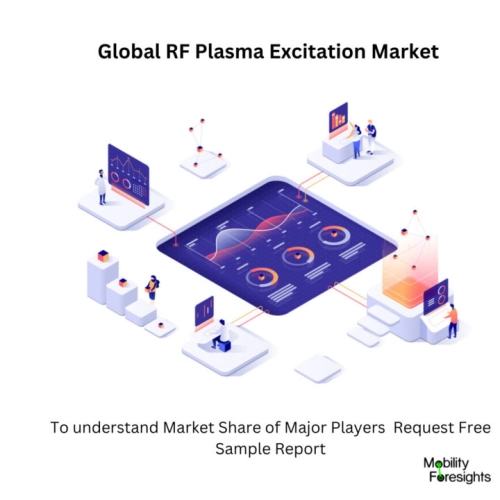
- Get in Touch with Us

Last Updated: Apr 25, 2025 | Study Period: 2023-2030
Plasma excitation refers to the process of energizing gas molecules to a higher energy state, resulting in a plasma state. This process is typically accomplished through the application of electric fields or microwaves. Plasma excitation is used in a wide range of applications, from industrial processes such as welding and cutting, to space exploration, to medical applications such as cancer treatment.
RF plasma excitation is a common method of plasma excitation, and involves the use of radio frequency (RF) waves to create a plasma. These RF fields can be used to excite electrons to higher energy levels, resulting in the creation of neutral gas molecules, ions, and electrons. This process is often referred to as radio frequency plasma (RFP) generation and is used in a variety of applications.
In RF plasma excitation, the RF field is typically generated by a transmitter and is applied to a chamber containing a gas. The RF field causes the atoms in the gas to become excited, resulting in the formation of electrons, ions, and neutral gas particles. The resulting plasma is then used for a variety of applications, such as surface cleaning, etching, and sputtering.
RF plasma excitation is a versatile technique, as the RF field can be adjusted for different applications, such as adjusting the frequency or the power of the RF field. Additionally, the RF field can be used in a variety of geometries, such as planar or cylindrical, to create a variety of plasma shapes.
Overall, RF plasma excitation is a common and versatile technique used in a variety of applications. It is a reliable and cost-effective method of creating a plasma, and can be used in both industrial and scientific applications.

The Global RF Plasma Excitation market accounted for $XX Billion in 2022 and is anticipated to reach $XX Billion by 2030, registering a CAGR of XX% from 2023 to 2030.
A radio frequency (RF) plasma thruster developed for spaceship electric propulsion. The thruster produces axial thrust by heating plasma in a magnetic field and allowing it to flow out along magnetic field lines.
While maintaining the benefits of RF plasma thrusters over other kinds of electric and chemical propulsion systems, the current invention significantly boosts the efficiency of RF plasma thrusters in comparison to earlier thrusters of this kind.
Because the lower hybrid wave produces high-density plasmas and is relatively easy to manufacture the antennas needed to link RF energy to the plasma, it is used. Because there isn't a hot electron population to absorb most of the RF power supplied to the plasma, substantially higher efficiency is possible as a result.
The low efficiency of RF plasma thrusters in the past has been mainly caused by power loss from a hot electron population that is produced when the plasma is heated by electron cyclotron resonance (ECR).
There are a number of drawbacks to using ECR. The main drawback is that the thruster loses power due to the formation of a hot electron population, which results in low efficiency.
Compared to other RF heating techniques, ECR heating has additional drawbacks in that it requires higher frequencies for a given set of plasma characteristics. In general, higher frequency radio frequency sources are more costly and less effective.
Furthermore, there needs to be an exact match between the magnetic field and frequency. Typically, plasma densities are constrained to be lower than the cutoff density at a certain frequency.
Since the RF field rotates at the same speed as the electron as it spirals around the magnetic field line, an electron in resonance with it effectively perceives a continuous DC field.
Until the energy is limited by another process, the electron's energy grows. When electron energy reaches a certain level, adiabatic invariant is no longer conserved and electrons are no longer trapped in the mirror, which is the ultimate limit for magnetic mirror machines. Generally, hotter particles can be heated more effectively by applying twice the fundamental frequency, which is how hot electrons are formed.
| Sl no | Topic |
| 1 | Market Segmentation |
| 2 | Scope of the report |
| 3 | Abbreviations |
| 4 | Research Methodology |
| 5 | Executive Summary |
| 6 | Introduction |
| 7 | Insights from Industry stakeholders |
| 8 | Cost breakdown of Product by sub-components and average profit margin |
| 9 | Disruptive innovation in the Industry |
| 10 | Technology trends in the Industry |
| 11 | Consumer trends in the industry |
| 12 | Recent Production Milestones |
| 13 | Component Manufacturing in US, EU and China |
| 14 | COVID-19 impact on overall market |
| 15 | COVID-19 impact on Production of components |
| 16 | COVID-19 impact on Point of sale |
| 17 | Market Segmentation, Dynamics and Forecast by Geography, 2023-2030 |
| 18 | Market Segmentation, Dynamics and Forecast by Product Type, 2023-2030 |
| 19 | Market Segmentation, Dynamics and Forecast by Application, 2023-2030 |
| 20 | Market Segmentation, Dynamics and Forecast by End use, 2023-2030 |
| 21 | Product installation rate by OEM, 2023 |
| 22 | Incline/Decline in Average B-2-B selling price in past 5 years |
| 23 | Competition from substitute products |
| 24 | Gross margin and average profitability of suppliers |
| 25 | New product development in past 12 months |
| 26 | M&A in past 12 months |
| 27 | Growth strategy of leading players |
| 28 | Market share of vendors, 2023 |
| 29 | Company Profiles |
| 30 | Unmet needs and opportunity for new suppliers |
| 31 | Conclusion |
| 32 | Appendix |